FORD F150 2023 Repair Manual
Manufacturer: FORD, Model Year: 2023, Model line: F150, Model: FORD F150 2023Pages: 786, PDF Size: 23.15 MB
Page 61 of 786
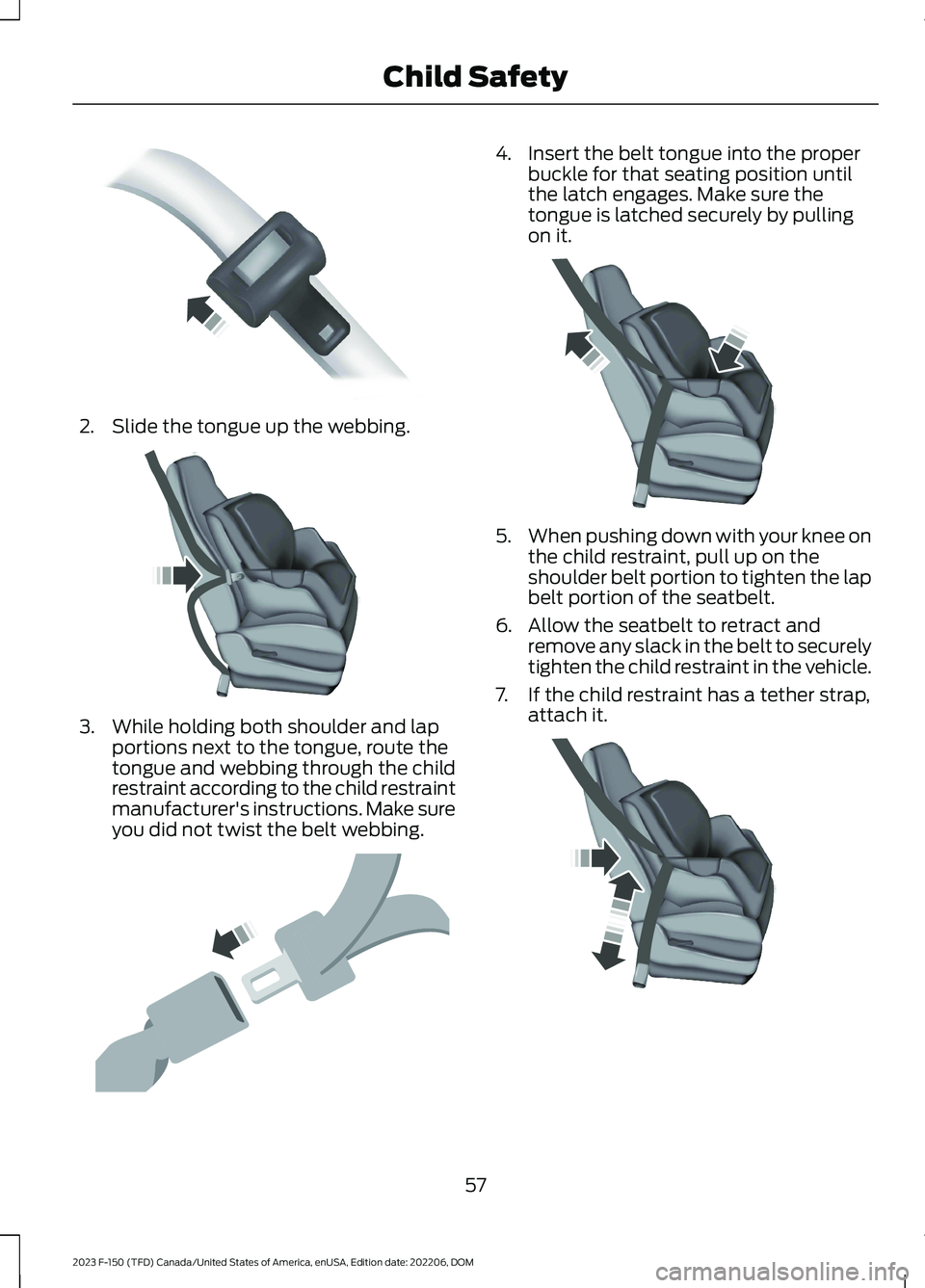
2.Slide the tongue up the webbing.
3.While holding both shoulder and lapportions next to the tongue, route thetongue and webbing through the childrestraint according to the child restraintmanufacturer's instructions. Make sureyou did not twist the belt webbing.
4.Insert the belt tongue into the properbuckle for that seating position untilthe latch engages. Make sure thetongue is latched securely by pullingon it.
5.When pushing down with your knee onthe child restraint, pull up on theshoulder belt portion to tighten the lapbelt portion of the seatbelt.
6.Allow the seatbelt to retract andremove any slack in the belt to securelytighten the child restraint in the vehicle.
7.If the child restraint has a tether strap,attach it.
57
2023 F-150 (TFD) Canada/United States of America, enUSA, Edition date: 202206, DOMChild SafetyE162708 E142530 E142531 E142533 E142534
Page 62 of 786
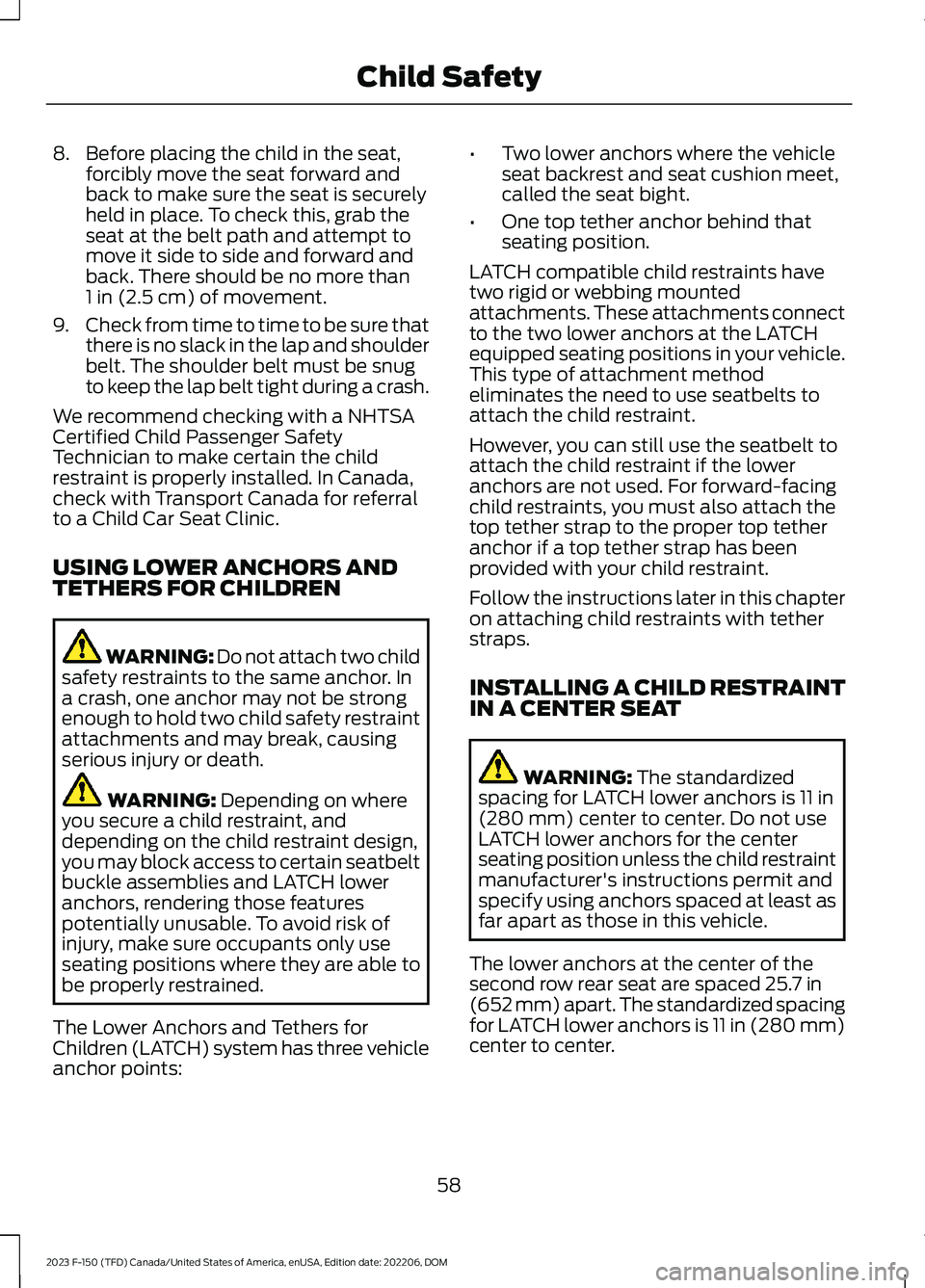
8.Before placing the child in the seat,forcibly move the seat forward andback to make sure the seat is securelyheld in place. To check this, grab theseat at the belt path and attempt tomove it side to side and forward andback. There should be no more than1 in (2.5 cm) of movement.
9.Check from time to time to be sure thatthere is no slack in the lap and shoulderbelt. The shoulder belt must be snugto keep the lap belt tight during a crash.
We recommend checking with a NHTSACertified Child Passenger SafetyTechnician to make certain the childrestraint is properly installed. In Canada,check with Transport Canada for referralto a Child Car Seat Clinic.
USING LOWER ANCHORS ANDTETHERS FOR CHILDREN
WARNING: Do not attach two childsafety restraints to the same anchor. Ina crash, one anchor may not be strongenough to hold two child safety restraintattachments and may break, causingserious injury or death.
WARNING: Depending on whereyou secure a child restraint, anddepending on the child restraint design,you may block access to certain seatbeltbuckle assemblies and LATCH loweranchors, rendering those featurespotentially unusable. To avoid risk ofinjury, make sure occupants only useseating positions where they are able tobe properly restrained.
The Lower Anchors and Tethers forChildren (LATCH) system has three vehicleanchor points:
•Two lower anchors where the vehicleseat backrest and seat cushion meet,called the seat bight.
•One top tether anchor behind thatseating position.
LATCH compatible child restraints havetwo rigid or webbing mountedattachments. These attachments connectto the two lower anchors at the LATCHequipped seating positions in your vehicle.This type of attachment methodeliminates the need to use seatbelts toattach the child restraint.
However, you can still use the seatbelt toattach the child restraint if the loweranchors are not used. For forward-facingchild restraints, you must also attach thetop tether strap to the proper top tetheranchor if a top tether strap has beenprovided with your child restraint.
Follow the instructions later in this chapteron attaching child restraints with tetherstraps.
INSTALLING A CHILD RESTRAINTIN A CENTER SEAT
WARNING: The standardizedspacing for LATCH lower anchors is 11 in(280 mm) center to center. Do not useLATCH lower anchors for the centerseating position unless the child restraintmanufacturer's instructions permit andspecify using anchors spaced at least asfar apart as those in this vehicle.
The lower anchors at the center of thesecond row rear seat are spaced 25.7 in(652 mm) apart. The standardized spacingfor LATCH lower anchors is 11 in (280 mm)center to center.
58
2023 F-150 (TFD) Canada/United States of America, enUSA, Edition date: 202206, DOMChild Safety
Page 63 of 786
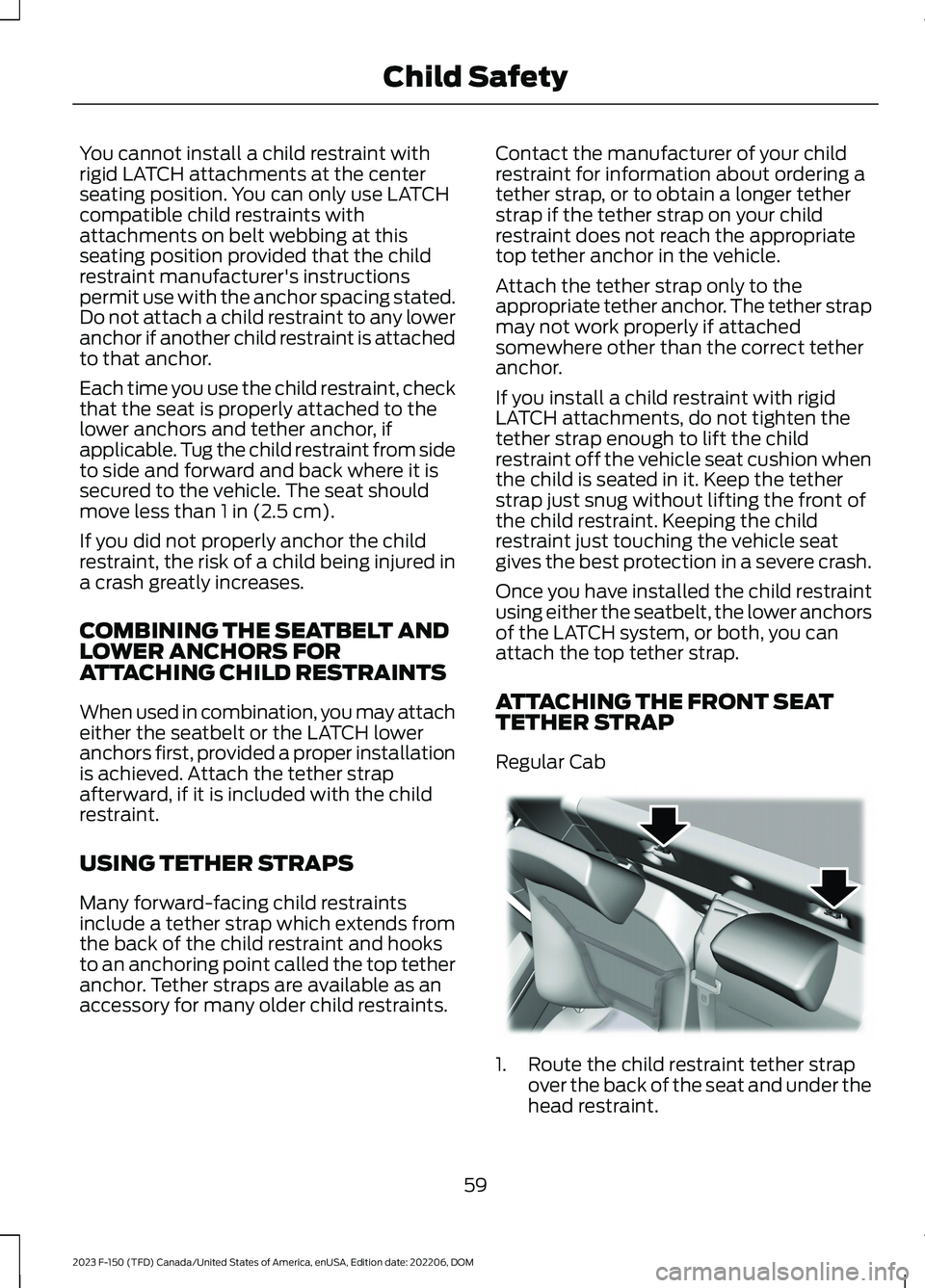
You cannot install a child restraint withrigid LATCH attachments at the centerseating position. You can only use LATCHcompatible child restraints withattachments on belt webbing at thisseating position provided that the childrestraint manufacturer's instructionspermit use with the anchor spacing stated.Do not attach a child restraint to any loweranchor if another child restraint is attachedto that anchor.
Each time you use the child restraint, checkthat the seat is properly attached to thelower anchors and tether anchor, ifapplicable. Tug the child restraint from sideto side and forward and back where it issecured to the vehicle. The seat shouldmove less than 1 in (2.5 cm).
If you did not properly anchor the childrestraint, the risk of a child being injured ina crash greatly increases.
COMBINING THE SEATBELT ANDLOWER ANCHORS FORATTACHING CHILD RESTRAINTS
When used in combination, you may attacheither the seatbelt or the LATCH loweranchors first, provided a proper installationis achieved. Attach the tether strapafterward, if it is included with the childrestraint.
USING TETHER STRAPS
Many forward-facing child restraintsinclude a tether strap which extends fromthe back of the child restraint and hooksto an anchoring point called the top tetheranchor. Tether straps are available as anaccessory for many older child restraints.
Contact the manufacturer of your childrestraint for information about ordering atether strap, or to obtain a longer tetherstrap if the tether strap on your childrestraint does not reach the appropriatetop tether anchor in the vehicle.
Attach the tether strap only to theappropriate tether anchor. The tether strapmay not work properly if attachedsomewhere other than the correct tetheranchor.
If you install a child restraint with rigidLATCH attachments, do not tighten thetether strap enough to lift the childrestraint off the vehicle seat cushion whenthe child is seated in it. Keep the tetherstrap just snug without lifting the front ofthe child restraint. Keeping the childrestraint just touching the vehicle seatgives the best protection in a severe crash.
Once you have installed the child restraintusing either the seatbelt, the lower anchorsof the LATCH system, or both, you canattach the top tether strap.
ATTACHING THE FRONT SEATTETHER STRAP
Regular Cab
1.Route the child restraint tether strapover the back of the seat and under thehead restraint.
59
2023 F-150 (TFD) Canada/United States of America, enUSA, Edition date: 202206, DOMChild SafetyE175295
Page 64 of 786
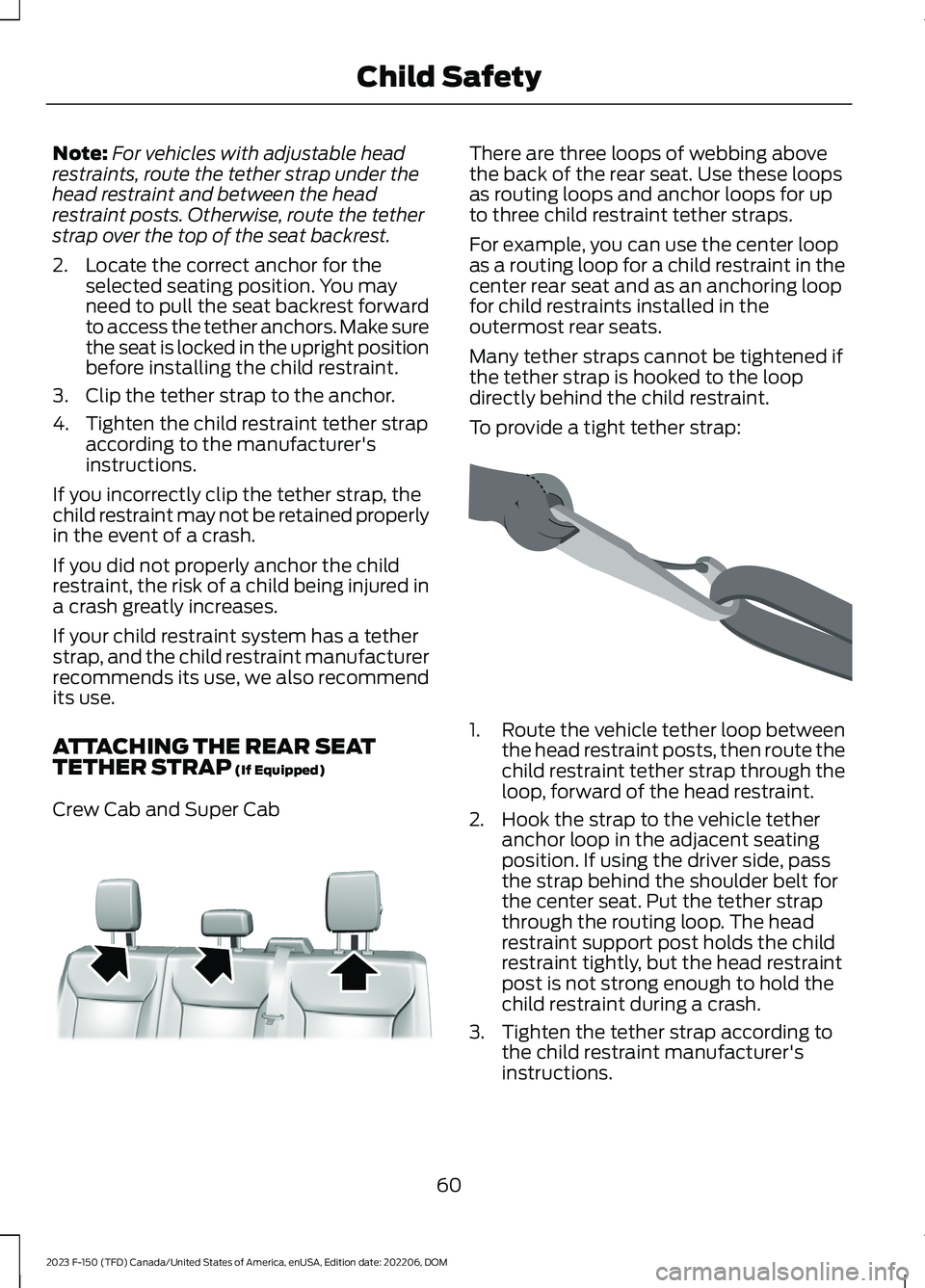
Note:For vehicles with adjustable headrestraints, route the tether strap under thehead restraint and between the headrestraint posts. Otherwise, route the tetherstrap over the top of the seat backrest.
2.Locate the correct anchor for theselected seating position. You mayneed to pull the seat backrest forwardto access the tether anchors. Make surethe seat is locked in the upright positionbefore installing the child restraint.
3.Clip the tether strap to the anchor.
4.Tighten the child restraint tether strapaccording to the manufacturer'sinstructions.
If you incorrectly clip the tether strap, thechild restraint may not be retained properlyin the event of a crash.
If you did not properly anchor the childrestraint, the risk of a child being injured ina crash greatly increases.
If your child restraint system has a tetherstrap, and the child restraint manufacturerrecommends its use, we also recommendits use.
ATTACHING THE REAR SEATTETHER STRAP (If Equipped)
Crew Cab and Super Cab
There are three loops of webbing abovethe back of the rear seat. Use these loopsas routing loops and anchor loops for upto three child restraint tether straps.
For example, you can use the center loopas a routing loop for a child restraint in thecenter rear seat and as an anchoring loopfor child restraints installed in theoutermost rear seats.
Many tether straps cannot be tightened ifthe tether strap is hooked to the loopdirectly behind the child restraint.
To provide a tight tether strap:
1.Route the vehicle tether loop betweenthe head restraint posts, then route thechild restraint tether strap through theloop, forward of the head restraint.
2.Hook the strap to the vehicle tetheranchor loop in the adjacent seatingposition. If using the driver side, passthe strap behind the shoulder belt forthe center seat. Put the tether strapthrough the routing loop. The headrestraint support post holds the childrestraint tightly, but the head restraintpost is not strong enough to hold thechild restraint during a crash.
3.Tighten the tether strap according tothe child restraint manufacturer'sinstructions.
60
2023 F-150 (TFD) Canada/United States of America, enUSA, Edition date: 202206, DOMChild SafetyE309318 E309384
Page 65 of 786
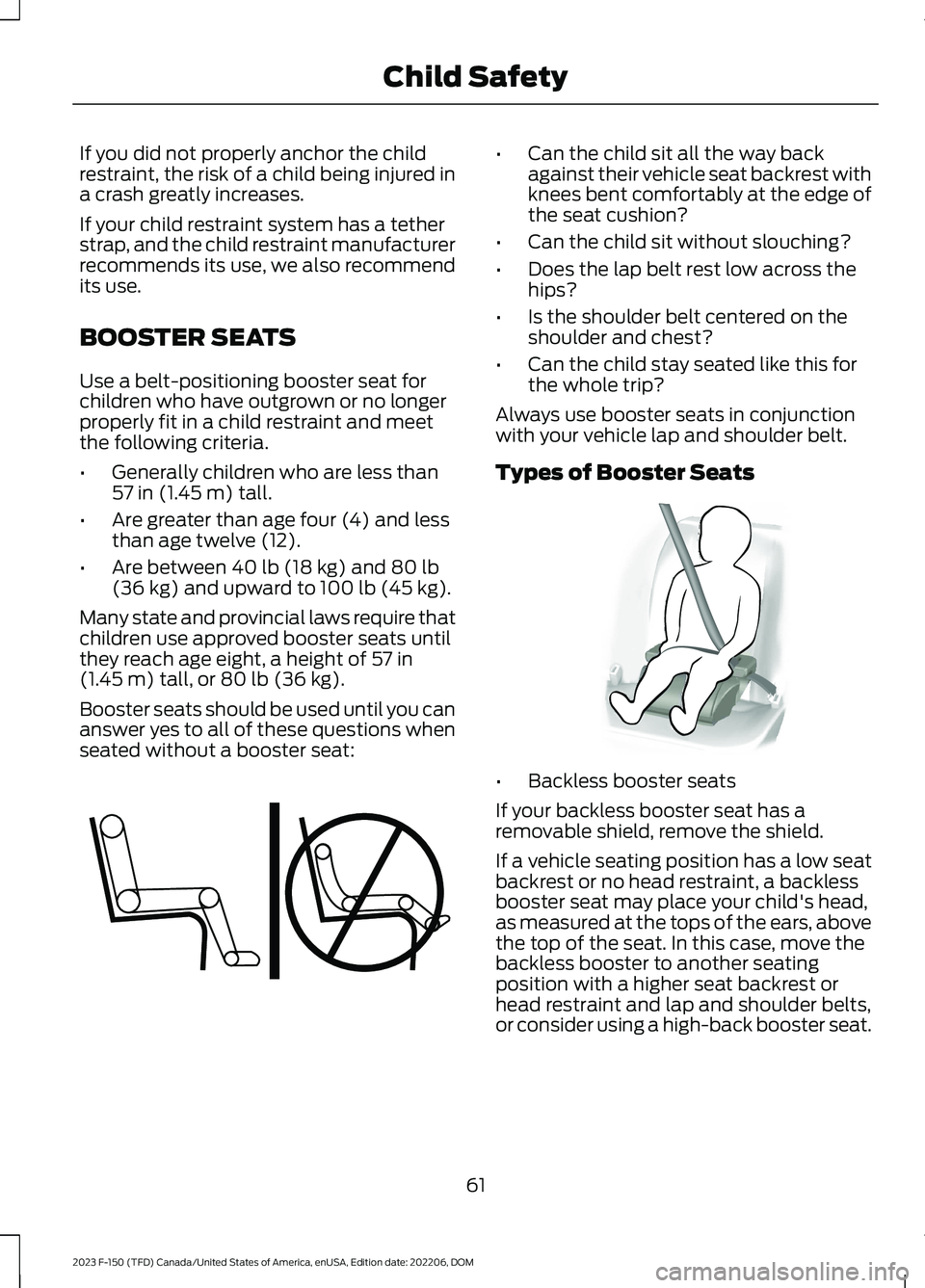
If you did not properly anchor the childrestraint, the risk of a child being injured ina crash greatly increases.
If your child restraint system has a tetherstrap, and the child restraint manufacturerrecommends its use, we also recommendits use.
BOOSTER SEATS
Use a belt-positioning booster seat forchildren who have outgrown or no longerproperly fit in a child restraint and meetthe following criteria.
•Generally children who are less than57 in (1.45 m) tall.
•Are greater than age four (4) and lessthan age twelve (12).
•Are between 40 lb (18 kg) and 80 lb(36 kg) and upward to 100 lb (45 kg).
Many state and provincial laws require thatchildren use approved booster seats untilthey reach age eight, a height of 57 in(1.45 m) tall, or 80 lb (36 kg).
Booster seats should be used until you cananswer yes to all of these questions whenseated without a booster seat:
•Can the child sit all the way backagainst their vehicle seat backrest withknees bent comfortably at the edge ofthe seat cushion?
•Can the child sit without slouching?
•Does the lap belt rest low across thehips?
•Is the shoulder belt centered on theshoulder and chest?
•Can the child stay seated like this forthe whole trip?
Always use booster seats in conjunctionwith your vehicle lap and shoulder belt.
Types of Booster Seats
•Backless booster seats
If your backless booster seat has aremovable shield, remove the shield.
If a vehicle seating position has a low seatbackrest or no head restraint, a backlessbooster seat may place your child's head,as measured at the tops of the ears, abovethe top of the seat. In this case, move thebackless booster to another seatingposition with a higher seat backrest orhead restraint and lap and shoulder belts,or consider using a high-back booster seat.
61
2023 F-150 (TFD) Canada/United States of America, enUSA, Edition date: 202206, DOMChild SafetyE142595 E68924
Page 66 of 786
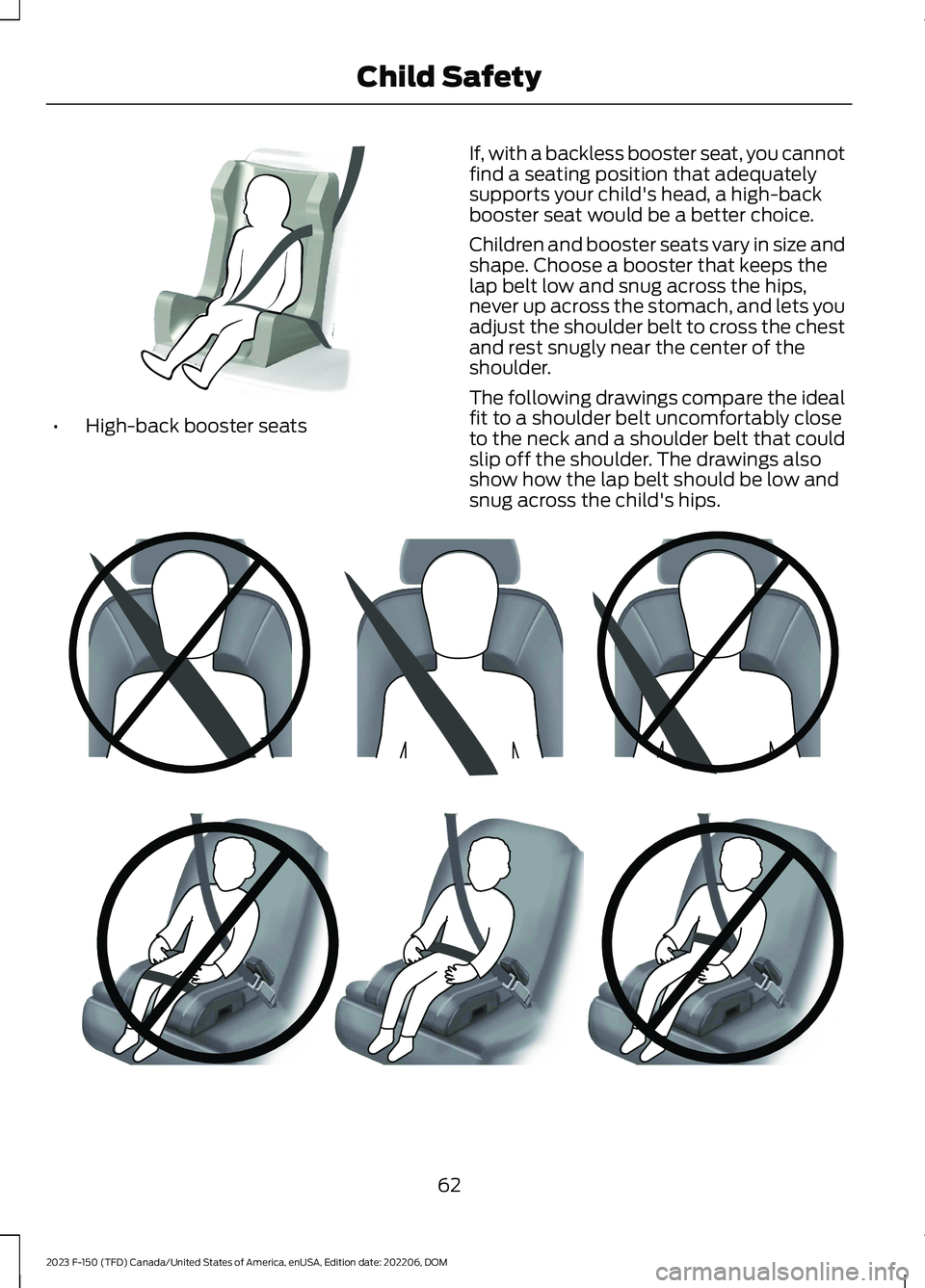
•High-back booster seats
If, with a backless booster seat, you cannotfind a seating position that adequatelysupports your child's head, a high-backbooster seat would be a better choice.
Children and booster seats vary in size andshape. Choose a booster that keeps thelap belt low and snug across the hips,never up across the stomach, and lets youadjust the shoulder belt to cross the chestand rest snugly near the center of theshoulder.
The following drawings compare the idealfit to a shoulder belt uncomfortably closeto the neck and a shoulder belt that couldslip off the shoulder. The drawings alsoshow how the lap belt should be low andsnug across the child's hips.
62
2023 F-150 (TFD) Canada/United States of America, enUSA, Edition date: 202206, DOMChild SafetyE70710 E142596 E142597
Page 67 of 786
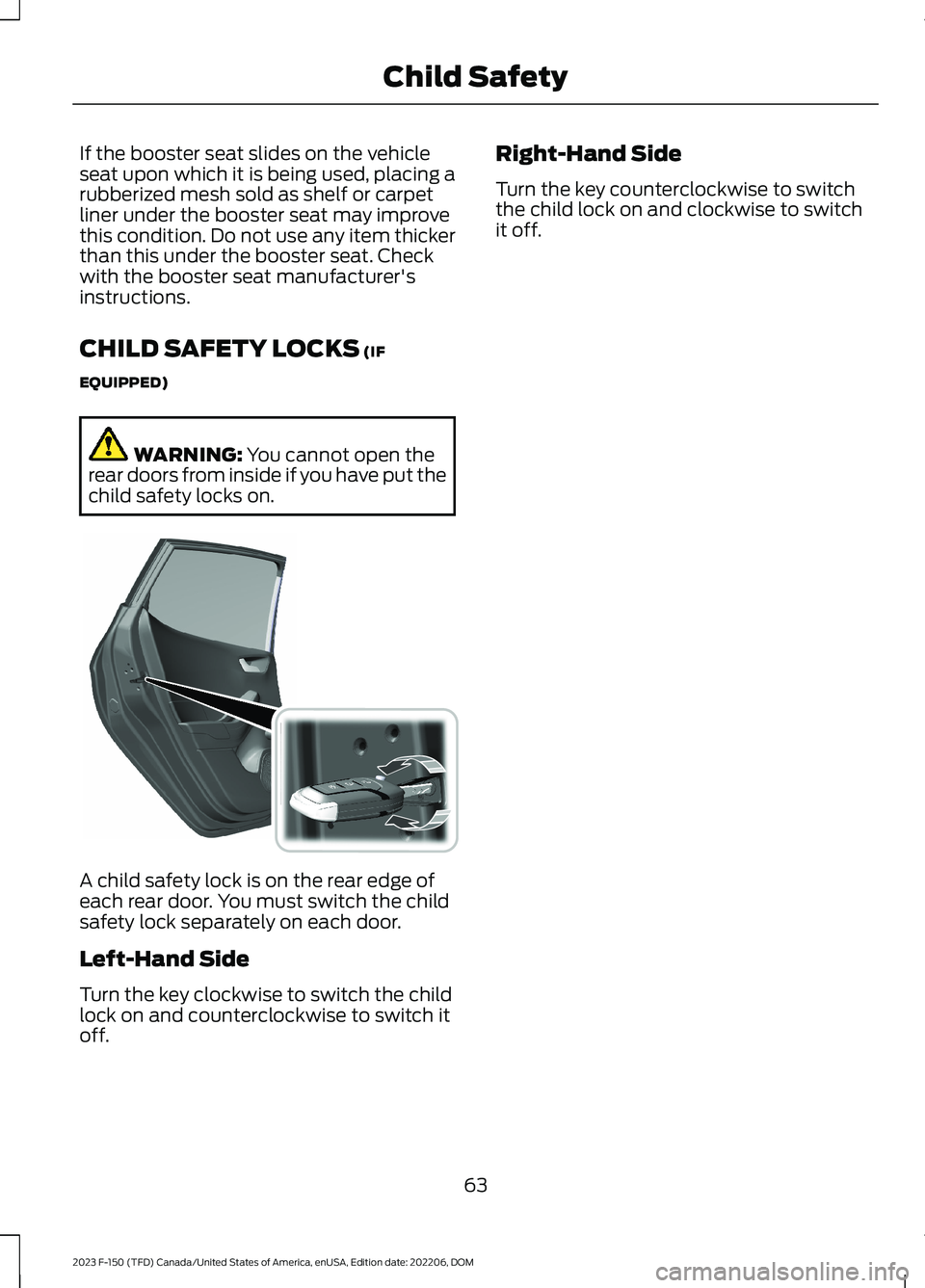
If the booster seat slides on the vehicleseat upon which it is being used, placing arubberized mesh sold as shelf or carpetliner under the booster seat may improvethis condition. Do not use any item thickerthan this under the booster seat. Checkwith the booster seat manufacturer'sinstructions.
CHILD SAFETY LOCKS (IF
EQUIPPED)
WARNING: You cannot open therear doors from inside if you have put thechild safety locks on.
A child safety lock is on the rear edge ofeach rear door. You must switch the childsafety lock separately on each door.
Left-Hand Side
Turn the key clockwise to switch the childlock on and counterclockwise to switch itoff.
Right-Hand Side
Turn the key counterclockwise to switchthe child lock on and clockwise to switchit off.
63
2023 F-150 (TFD) Canada/United States of America, enUSA, Edition date: 202206, DOMChild Safety E238364
Page 68 of 786
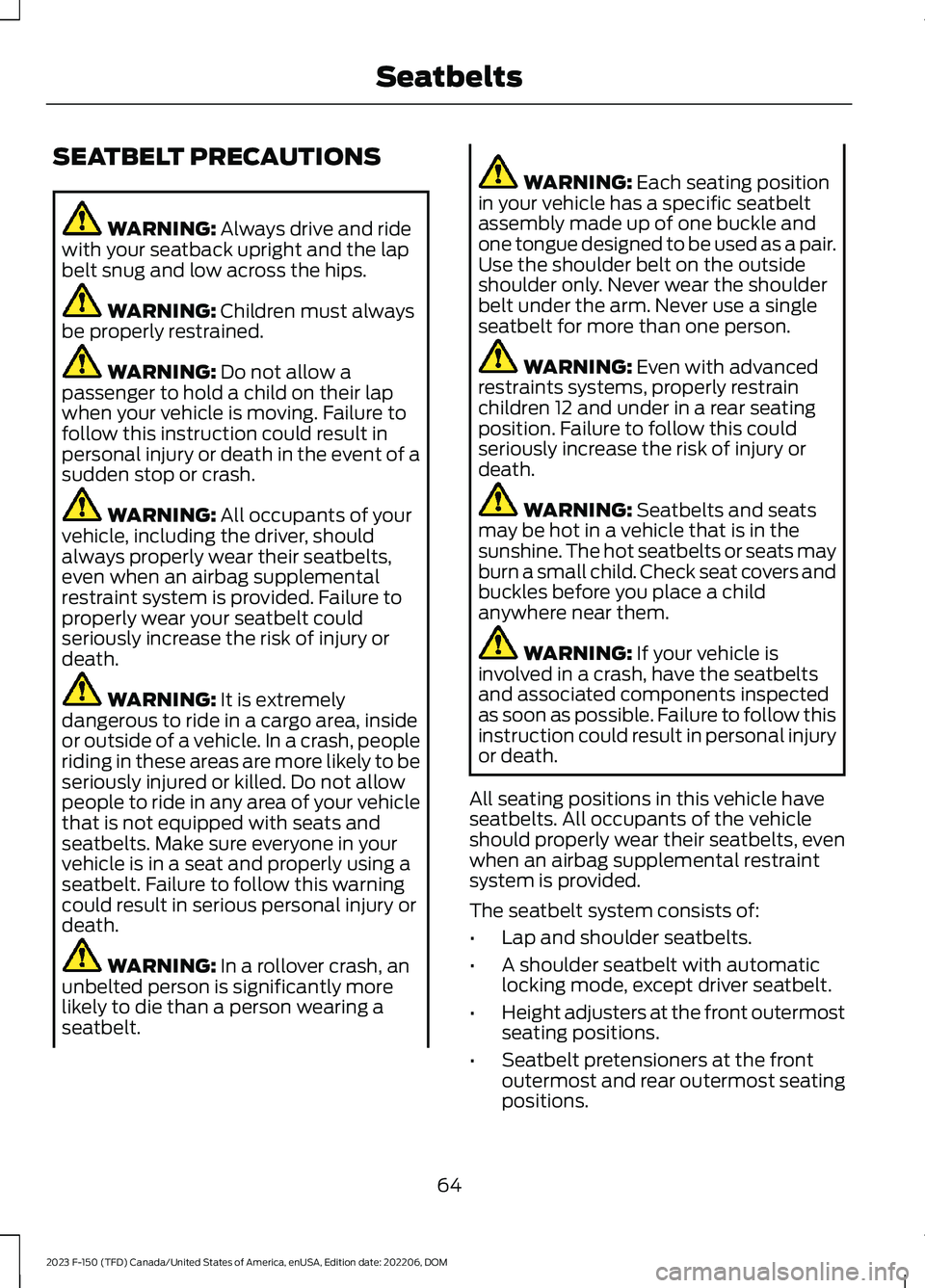
SEATBELT PRECAUTIONS
WARNING: Always drive and ridewith your seatback upright and the lapbelt snug and low across the hips.
WARNING: Children must alwaysbe properly restrained.
WARNING: Do not allow apassenger to hold a child on their lapwhen your vehicle is moving. Failure tofollow this instruction could result inpersonal injury or death in the event of asudden stop or crash.
WARNING: All occupants of yourvehicle, including the driver, shouldalways properly wear their seatbelts,even when an airbag supplementalrestraint system is provided. Failure toproperly wear your seatbelt couldseriously increase the risk of injury ordeath.
WARNING: It is extremelydangerous to ride in a cargo area, insideor outside of a vehicle. In a crash, peopleriding in these areas are more likely to beseriously injured or killed. Do not allowpeople to ride in any area of your vehiclethat is not equipped with seats andseatbelts. Make sure everyone in yourvehicle is in a seat and properly using aseatbelt. Failure to follow this warningcould result in serious personal injury ordeath.
WARNING: In a rollover crash, anunbelted person is significantly morelikely to die than a person wearing aseatbelt.
WARNING: Each seating positionin your vehicle has a specific seatbeltassembly made up of one buckle andone tongue designed to be used as a pair.Use the shoulder belt on the outsideshoulder only. Never wear the shoulderbelt under the arm. Never use a singleseatbelt for more than one person.
WARNING: Even with advancedrestraints systems, properly restrainchildren 12 and under in a rear seatingposition. Failure to follow this couldseriously increase the risk of injury ordeath.
WARNING: Seatbelts and seatsmay be hot in a vehicle that is in thesunshine. The hot seatbelts or seats mayburn a small child. Check seat covers andbuckles before you place a childanywhere near them.
WARNING: If your vehicle isinvolved in a crash, have the seatbeltsand associated components inspectedas soon as possible. Failure to follow thisinstruction could result in personal injuryor death.
All seating positions in this vehicle haveseatbelts. All occupants of the vehicleshould properly wear their seatbelts, evenwhen an airbag supplemental restraintsystem is provided.
The seatbelt system consists of:
•Lap and shoulder seatbelts.
•A shoulder seatbelt with automaticlocking mode, except driver seatbelt.
•Height adjusters at the front outermostseating positions.
•Seatbelt pretensioners at the frontoutermost and rear outermost seatingpositions.
64
2023 F-150 (TFD) Canada/United States of America, enUSA, Edition date: 202206, DOMSeatbelts
Page 69 of 786
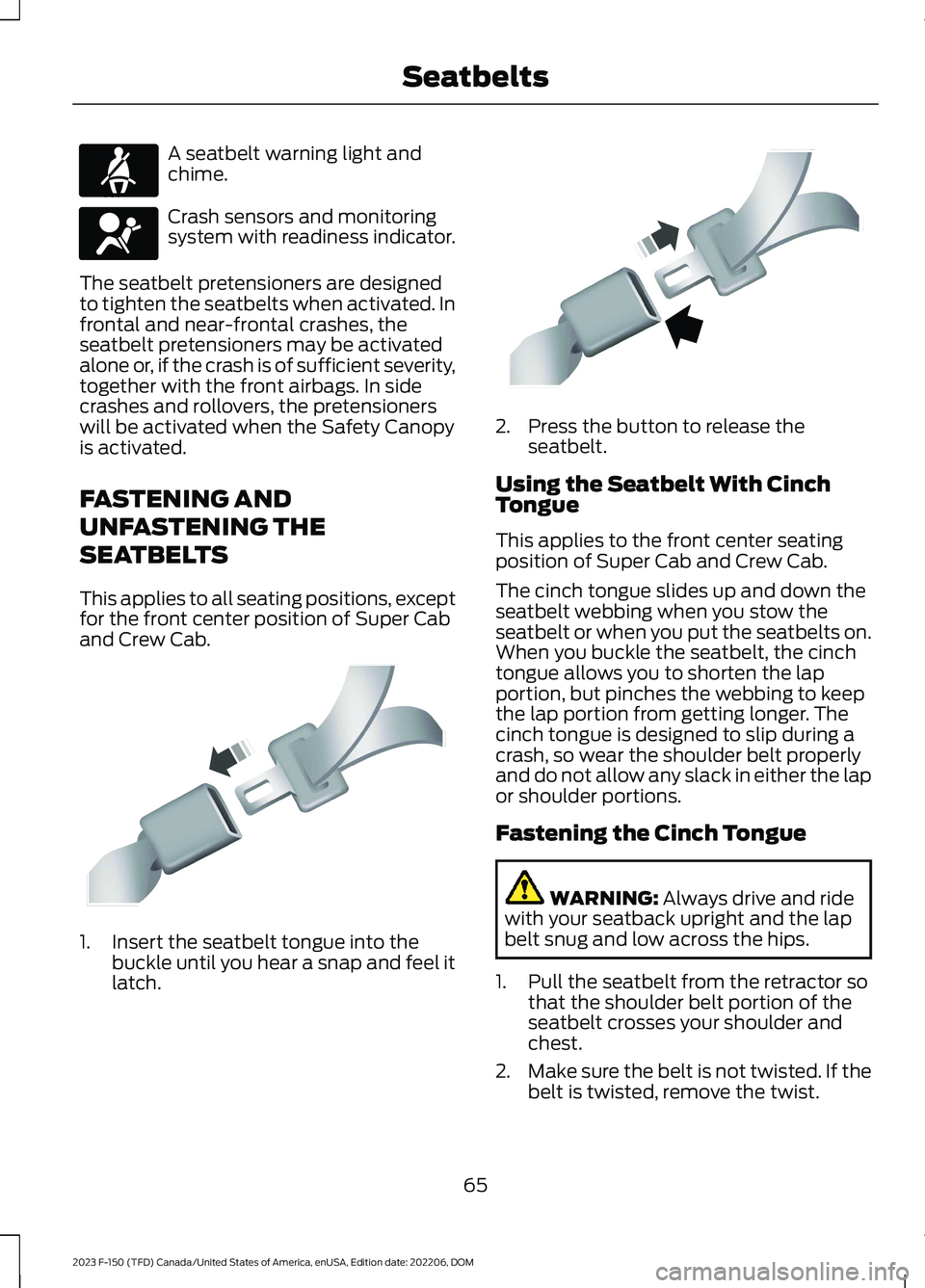
A seatbelt warning light andchime.
Crash sensors and monitoringsystem with readiness indicator.
The seatbelt pretensioners are designedto tighten the seatbelts when activated. Infrontal and near-frontal crashes, theseatbelt pretensioners may be activatedalone or, if the crash is of sufficient severity,together with the front airbags. In sidecrashes and rollovers, the pretensionerswill be activated when the Safety Canopyis activated.
FASTENING AND
UNFASTENING THE
SEATBELTS
This applies to all seating positions, exceptfor the front center position of Super Caband Crew Cab.
1.Insert the seatbelt tongue into thebuckle until you hear a snap and feel itlatch.
2.Press the button to release theseatbelt.
Using the Seatbelt With CinchTongue
This applies to the front center seatingposition of Super Cab and Crew Cab.
The cinch tongue slides up and down theseatbelt webbing when you stow theseatbelt or when you put the seatbelts on.When you buckle the seatbelt, the cinchtongue allows you to shorten the lapportion, but pinches the webbing to keepthe lap portion from getting longer. Thecinch tongue is designed to slip during acrash, so wear the shoulder belt properlyand do not allow any slack in either the lapor shoulder portions.
Fastening the Cinch Tongue
WARNING: Always drive and ridewith your seatback upright and the lapbelt snug and low across the hips.
1.Pull the seatbelt from the retractor sothat the shoulder belt portion of theseatbelt crosses your shoulder andchest.
2.Make sure the belt is not twisted. If thebelt is twisted, remove the twist.
65
2023 F-150 (TFD) Canada/United States of America, enUSA, Edition date: 202206, DOMSeatbeltsE71880 E67017 E142587 E142588
Page 70 of 786
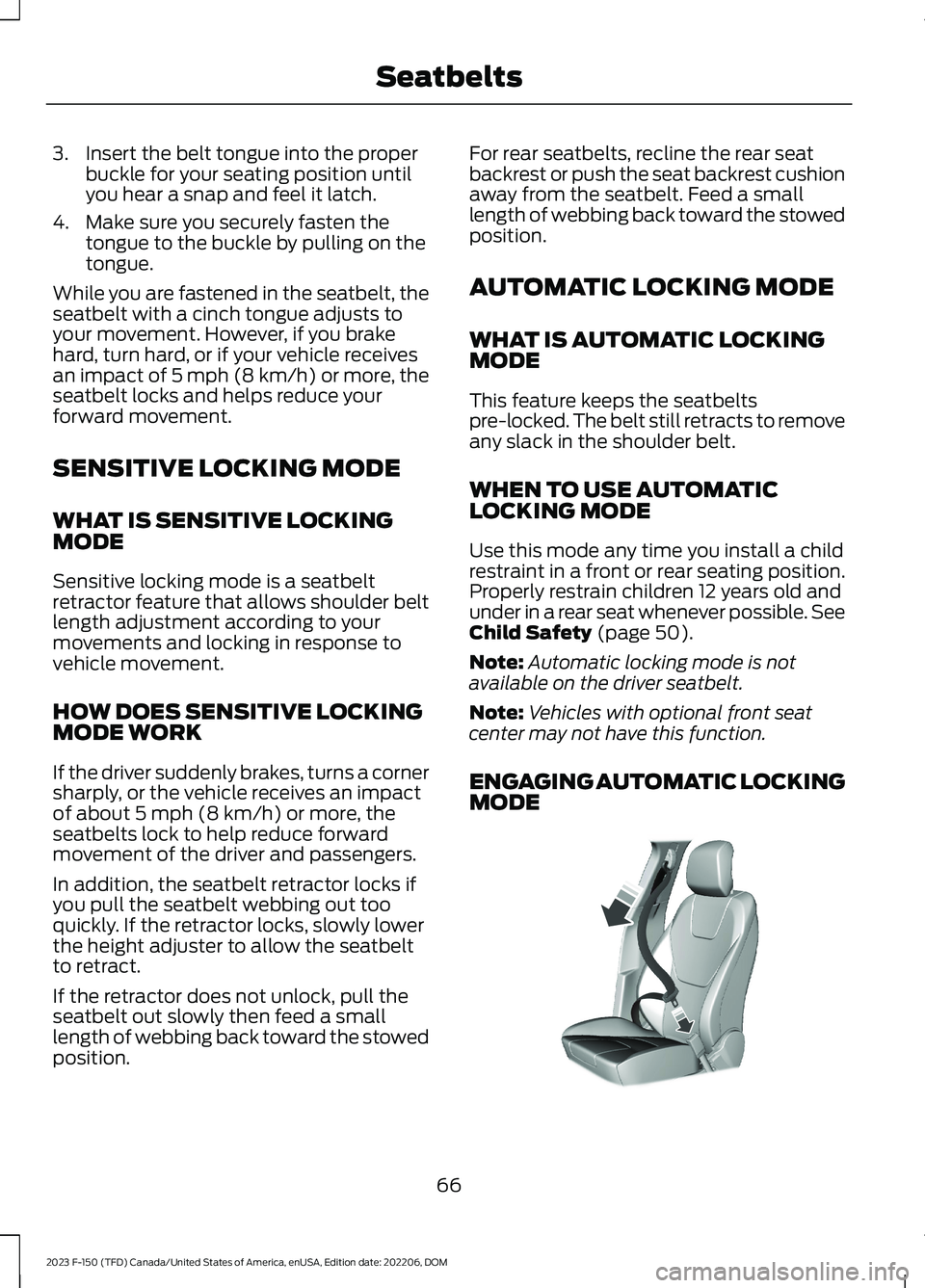
3.Insert the belt tongue into the properbuckle for your seating position untilyou hear a snap and feel it latch.
4.Make sure you securely fasten thetongue to the buckle by pulling on thetongue.
While you are fastened in the seatbelt, theseatbelt with a cinch tongue adjusts toyour movement. However, if you brakehard, turn hard, or if your vehicle receivesan impact of 5 mph (8 km/h) or more, theseatbelt locks and helps reduce yourforward movement.
SENSITIVE LOCKING MODE
WHAT IS SENSITIVE LOCKINGMODE
Sensitive locking mode is a seatbeltretractor feature that allows shoulder beltlength adjustment according to yourmovements and locking in response tovehicle movement.
HOW DOES SENSITIVE LOCKINGMODE WORK
If the driver suddenly brakes, turns a cornersharply, or the vehicle receives an impactof about 5 mph (8 km/h) or more, theseatbelts lock to help reduce forwardmovement of the driver and passengers.
In addition, the seatbelt retractor locks ifyou pull the seatbelt webbing out tooquickly. If the retractor locks, slowly lowerthe height adjuster to allow the seatbeltto retract.
If the retractor does not unlock, pull theseatbelt out slowly then feed a smalllength of webbing back toward the stowedposition.
For rear seatbelts, recline the rear seatbackrest or push the seat backrest cushionaway from the seatbelt. Feed a smalllength of webbing back toward the stowedposition.
AUTOMATIC LOCKING MODE
WHAT IS AUTOMATIC LOCKINGMODE
This feature keeps the seatbeltspre-locked. The belt still retracts to removeany slack in the shoulder belt.
WHEN TO USE AUTOMATICLOCKING MODE
Use this mode any time you install a childrestraint in a front or rear seating position.Properly restrain children 12 years old andunder in a rear seat whenever possible. SeeChild Safety (page 50).
Note:Automatic locking mode is notavailable on the driver seatbelt.
Note:Vehicles with optional front seatcenter may not have this function.
ENGAGING AUTOMATIC LOCKINGMODE
66
2023 F-150 (TFD) Canada/United States of America, enUSA, Edition date: 202206, DOMSeatbeltsE142591